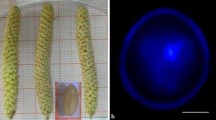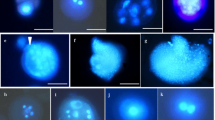Abstract
Routine production of haploid plants has not been reported for any legume, despite the major role these species play in sustainable farming systems and human nutrition. It is within this context that we report a protocol for the induction of haploid development in chickpea (Cicer arietinum L.) using isolated microspore culture. The cultivars “Rupali”, “Narayen”, and “Kimberley Large” were identified as responsive to isolated microspore culture. Flower bud length and microspore developmental stage were correlated for these cultivars. Depending on the cultivar, buds 2.85–3.5 mm in length contained uninucleate microspores. Microspores from donor plants grown in winter and spring were more responsive than those grown in summer. A cold treatment (4°C) of between 24 and 48 h enhanced microspore response in winter- and spring-grown material but was not effective in summer-grown material. A medium developed by the authors was effective for microspore induction and early-stage embryo development. The addition of hormones to this medium was promotive of microspore induction in winter- and spring-grown material, but not in summer-grown material. The initial haploid division predominantly occurred via symmetrical division of the vegetative nucleus. Further research is under way to convert pro-embryos into plants.






Similar content being viewed by others
References
Bourgin J. P.; Nitsch J. Obtention de Nicotiana haplöides a partir d’étamines cultives in vitro. Ann Physiol Végét 9: 377–382; 1967.
Carreda S.; Clément C. Androgenesis and albinism in Poaceae: influence of genotype and carbohydrates. In: Clément C.; Pacini E.; Audran J. C. (eds) Anther and pollen: from biology to biotechnology. Springer, Berlin, Germany, pp 211–228; 1999.
Chanana N. P.; Dhawan V.; Bhojwani S. S. Morphogenesis in isolated microspore cultures of Brassica juncea. Plant Cell Tiss Org 83: 169–177; 2005.
Chen Y.; Wang R. F.; Tian W. Z. Studies on pollen culture in vitro and induction of plantlets in Oryza sativa Subsp. Keng Acta Genet Sinica 7: 46–54; 1980 (in Chinese).
Chu CC. The N6 medium and its application to anther culture of cereal crops (1978). In: Proceedings of Symposium on Plant Tissue Culture, May 25–30 Science Press, Beijing, China: 43–50
Chuong P. V.; Deslauriers C.; Kott L. S.; Beversdorf W. D. Effects of donor genotype and bud sampling on microspore culture of Brassica napus. Can J Bot 66: 1653–1657; 1988.
Coumans M. P.; Sohota S.; Swanson E. B. Plant development from isolated microspores of Zea mays L. Plant Cell Rep 7: 618–621; 1989.
Croser J. S.; Lulsdorf M. M.; Davies P. J.; Clarke H. J.; Bayliss K. L.; Mallikarjuna N.; Siddique K. H. M. Toward doubled haploid production in the Fabaceae: progress, constraints and opportunities. Crit Rev Plant Sci 25: 139–159; 2006.
Custers J. B. N.; Cordewener J. H. G.; Nöllen Y.; Dons J. J. M.; van Lookeren-Campagne M. M. Temperature controls both gametophytic and sporophytic development in microspore culture of Brassica napus. Plant Cell Rep 13: 267–271; 1994.
da Silva L. M.; Kaltchuk-Santos E.; Hu C. Y.; Callegari-Jacques S. M.; Bodanese-Zanettini M. H. Association between floral bud size and developmental stage in soybean microspores. Brazilian Arch Biol Technol 46: 515–520; 2003.
Delaitre C.; Ochatt S.; Deleury E. Electroporation modulates the embryogenic responses of asparagus (Asparagus officinalis L) microspore. Protoplasma 216: 39–46; 2001.
Germana M. A. Doubled haploid production in fruit crops. Plant Cell Tiss Org Cult 86: 131–146; 2006.
Grewal R. K.; Lulsdorf M.; Croser J. S.; Ochatt S.; Vandenberg A.; Warkentin T. D. Doubled haploid production in chickpea: role of stress treatments. Plant Cell Rep 28: 1289–1299; 2009.
Guha S.; Maheshwari S. C. In vitro production of embryos from anthers of Datura. Nature 204: 497; 1964.
Harlow C.; Hamza S.; Chupeau Y.; Pelletier G. Conditional lethal markers: spontaneous haploid selection in plants. In: Jain S. M.; Sopory S. K.; Veilleux R. E. (eds) In vitro haploid production in higher plants, vol. 1. Kluwer Academic Publishers, Dordrecht, The Netherlands, pp 297–315; 1996.
Höfer M. In vitro androgenesis in apple—improvement of the induction phase. Plant Cell Rep 22: 365–370; 2004.
Höfer M.; Touraev A.; Heberle-Bors E. Induction of embryogenesis from isolated apple microspores. Plant Cell Rep 18: 1012–1017; 1999.
Hsu J. C. Multiple comparisons—theory and methods. Chapman and Hall, London, UK; 1996.
Hu T.; Kasha K. J. A cytological study of pretreatments used to improve isolated microspore cultures of wheat (Triticum aestivum L.) cv. Chris Genome 42: 432–441; 1999.
Jacquard C.; Asakaviciute R.; Hamalian A. M.; Sangwan R. S.; Devaux P.; Clément C. Barley anther culture: effects of annual cycle and spike position on microspore embryogenesis and albinism. Plant Cell Rep 25: 375–381; 2006.
Kaltchuk-Santos E.; Mariath J. E.; Mundstock E.; Hu C. Y.; Bodanese-Zanettini M. H. Cytological analysis of early microspore divisions and embryo formation in cultured soybean anthers. Plant Cell Tiss Org Cult 49: 107–115; 1997.
Kaur P.; Bhalla J. K. Regeneration of haploid plants from microspore culture of pigeonpea (Cajanus cajan L.). Indian J Exp Biol 36: 736–738; 1998.
Kasha K. J.; Simion E.; Oro R.; Yao Q. A.; Hu T. C.; Carlson A. R. An improved in vitro technique for isolated microspore culture of barley. Euphytica 120: 379–385; 2001.
Kohler F.; Wenzel G. Regeneration of isolated barley microspores in conditioned media and trials to characterize the responsible factor. J Plant Physiol 121: 181–191; 1985.
Kyo M.; Harada H. Control of the developmental pathway of tobacco pollen in vitro. Planta 168: 427–432; 1986.
Lichter R. Induction of haploid plants from isolated pollen of Brassica napus. Z. Pflanzenphysiol 105: 427–434; 1982.
Lin R.; Yang H.; Khan T. N.; Siddique K. H. M.; Yan G. Characterisation of genetic diversity and DNA fingerprinting of Australian chickpea (Cicer arietinum L.) cultivars using MFLP markers. Aust J Agric Res 59: 707–713; 2008.
Linsmaier E. M.; Skoog F. Organic growth factor requirements of tobacco tissue cultures. Physiol Plant 18: 100–127; 1965.
Maluszynski M.; Kasha K. J.; Forster B. P.; Szarejko I. Doubled haploid production in crop plants. Kluwer Academic Publishers, Dordrecht, The Netherlands; 2003.
Mix G.; Wang H. M. In vitro generation of haploid plants (Vigna unguiculata L). Landbauforsch Volk 38: 305–309; 1988.
Murashige T.; Skoog F. A revised medium for rapid growth and bioassays with tobacco tissue cultures. Physiol Plant 15: 473–497; 1962.
Nitsch J. P.; Nitsch C. Haploid plants from pollen grains. Science 163: 85–87; 1969.
Ochatt S. J.; Pech C.; Grewal R.; Conreux C.; Lulsdorf M.; Jacas L. Abiotic stress enhances androgenesis from isolated microspores of some legume species (Fabaceae). J Plant Physiol 166: 1314–1328; 2009.
Ormerod A. J.; Caligari P. D. S. Anther and microspore culture of Lupinus albus in liquid culture medium. Plant Cell Tiss Org 36: 227–236; 1994.
Pal A. Isolated microspore culture of the winged bean, Psophocarpus tetragonolobus (L) DC—growth, development and chromosomal status. Indian J Exp Biol 21: 597–599; 1983.
Pechan P. M.; Keller W. A. Identification of potentially embryogenic microspores in Brassica napus. Physiol Planta 74: 377–384; 1988.
Pescitelli S. M.; Johnson C. D.; Petolino J. F. Isolated microspore culture of maize: effects of isolation technique, reduced temperature, and sucrose level. Plant Cell Rep 8: 628–631; 1990.
Siebel J.; Pauls K. P. A comparison of anther and microspore culture as a breeding tool in Brassica napus. Theor Appl Genet 78: 473–479; 1989.
Touraev A.; Vicente O.; Heberle-Bors E. Initiation of microspore embryogenesis by stress. Trends Plant Sci 2: 297–302; 1997.
Vicente O.; Garrido D.; Zarsky V.; Eller N.; Rihova L.; Berenyi M.; Tupy J.; Heberle-Bors E. Induction of embryogenesis in isolated pollen cultures of tobacco. In: Ottaviano E.; Mulcahy D. L.; Sari-Govla M.; Mulcahy G. B. (eds) Angiosperm pollen and ovules. Springer, New York, NY, USA, pp 279–284; 1992.
Wei Z. M.; Kyo M.; Harada H. Callus formation and plant regeneration through direct culture of isolated pollen of Hordeum vulgare cv. ‘Sabarlis’. Theor Appl Genet 72: 252–255; 1986.
White P. R. A handbook of plant tissue culture. Jacques Catlell Press, Lancaster, Pennsylvania, USA; 1943.
Willcox M. C.; Reed S. M.; Burns J. A.; Wynne J. C. Effect of microspore stage and media on anther culture of peanut (Arachis hypogaea L.). Plant Cell Tiss Org Cult 24: 25–28; 1991.
Xu R. Y.; Niimi Y. Cold treatment effects microspore development and induces IAA production in pollen sacs in tulip. Sci Hortic 115: 168–175; 2008.
Yeung E. C. The canola microspore derived embryo as a model system to study developmental processes in plants. J Plant Biol 45: 119–133; 2002.
Zaki M. A. M.; Dickinson H. G. Microspore-derived embryos in Brassica: the significance of division symmetry in pollen mitosis I to embryogenic development. Sex Plant Reprod 4: 48–55; 1991.
Zarsky V.; Eller D.; Garrido J.; Tupy J.; Schoffi F.; Vicente O.; Heberle-Bors E. Activation of a small heat shock gene during induction of tobacco pollen embryogenesis by starvation. In: Heberle-Bors E.; Hess M.; Vicente O. (eds) Frontiers in sexual plant reproduction research. Vienna University Press, Vienna, Austria, p 15; 1994.
Zarsky V.; Garrido D.; Rihova L.; Tupy J.; Vicente O.; Heberle-Bors E. Depression of the cell cycle by starvation is involved in the induction of tobacco pollen embryogenesis. Sex Plant Reprod 5: 189–194; 1992.
Acknowledgment
The authors are indebted to Ms Kylie Edwards for technical expertise and Dr Sergio Ochatt for his ongoing support, advice and collaboration. Thanks to Ms Padmaja Raman (The University of Western Australia) for statistical support and Dr Christine Davies (Tweakediting) for manuscript editing. The authors wish to acknowledge and thank their funding bodies, including the Grains Research and Development Corporation (GRDC), Canberra, Australia, Australian Research Council (ARC), Canberra, Australia, Council of Grain Grower Organisations Pty Ltd. (COGGO), South Perth, Australia and the Department of Agriculture and Food Western Australia (DAFWA), South Perth, Australia. This research was supported under Australian Research Council’s Industry Linkage Projects funding scheme (project number LP 056211).
Author information
Authors and Affiliations
Corresponding author
Additional information
Editor: Y. Takahata
Rights and permissions
About this article
Cite this article
Croser, J.S., Lulsdorf, M.M., Grewal, R.K. et al. Isolated microspore culture of chickpea (Cicer arietinum L.): induction of androgenesis and cytological analysis of early haploid divisions. In Vitro Cell.Dev.Biol.-Plant 47, 357–368 (2011). https://doi.org/10.1007/s11627-011-9346-7
Received:
Accepted:
Published:
Issue Date:
DOI: https://doi.org/10.1007/s11627-011-9346-7




